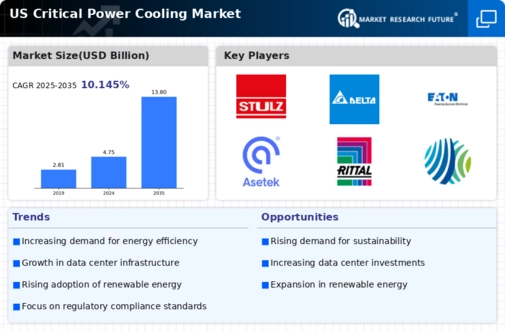Rising Demand for Data Centers
The increasing reliance on digital services and cloud computing has led to a surge in data center construction across the US. This trend is driving the critical power-cooling market as data centers require robust cooling solutions to maintain optimal operating conditions. According to industry estimates, the data center market is projected to grow at a CAGR of approximately 10% through 2026, necessitating advanced cooling technologies. As data centers expand, the demand for efficient power-cooling systems becomes paramount to ensure reliability and performance. The critical power-cooling market is thus positioned to benefit from this growth, as operators seek to enhance energy efficiency while managing heat loads effectively.
Increased Focus on Sustainability
Sustainability has emerged as a key priority for many organizations in the US, influencing their operational strategies. The critical power-cooling market is experiencing growth as companies seek to implement eco-friendly cooling solutions that minimize environmental impact. This shift is driven by consumer demand for sustainable practices and corporate responsibility initiatives. Many organizations are adopting cooling technologies that utilize renewable energy sources or have lower carbon footprints. The critical power-cooling market is thus evolving to meet these demands, with innovations such as liquid cooling and free cooling systems gaining traction. This focus on sustainability not only enhances brand reputation but can also lead to cost savings in energy consumption.
Regulatory Compliance and Standards
In the US, regulatory frameworks governing energy consumption and environmental impact are becoming increasingly stringent. Organizations are compelled to comply with regulations that mandate energy efficiency and emissions reductions. This regulatory landscape is a significant driver for the critical power-cooling market, as companies invest in advanced cooling technologies to meet compliance requirements. For instance, the Energy Policy Act and various state-level initiatives encourage the adoption of energy-efficient cooling solutions. As a result, the critical power-cooling market is witnessing heightened demand for systems that not only comply with regulations but also contribute to sustainability goals, potentially reducing operational costs by up to 20%.
Growth of High-Performance Computing
The rise of high-performance computing (HPC) applications in sectors such as research, finance, and artificial intelligence is significantly impacting the critical power-cooling market. HPC systems generate substantial heat, necessitating advanced cooling solutions to maintain performance and reliability. The market for HPC is expected to grow at a CAGR of around 8% over the next few years, further driving the need for effective cooling systems. As organizations invest in HPC infrastructure, the critical power-cooling market must adapt to provide innovative solutions that can handle the increased thermal loads while ensuring energy efficiency. This trend highlights the importance of specialized cooling technologies tailored for HPC environments.
Technological Advancements in Cooling Solutions
The critical power-cooling market is being propelled by rapid technological advancements that enhance cooling efficiency and effectiveness. Innovations such as AI-driven cooling management systems and advanced refrigerants are transforming how cooling systems operate. These technologies allow for real-time monitoring and optimization of cooling processes, which can lead to energy savings of up to 30%. As organizations increasingly adopt smart technologies, the critical power-cooling market is likely to see a shift towards more integrated and automated cooling solutions. This trend not only improves operational efficiency but also aligns with the broader movement towards digital transformation in various sectors.
























Leave a Comment